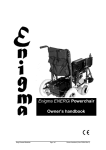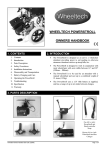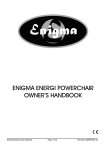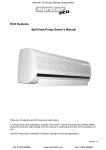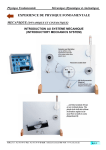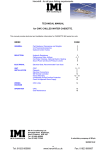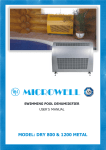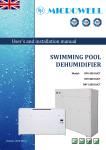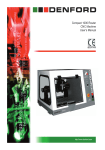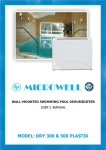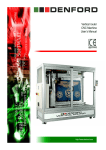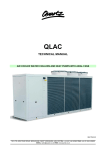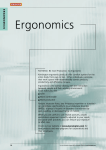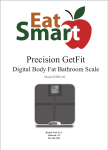Download cbc
Transcript
CBC CHILLED BEAM CASSETTE Int. Pat. App. WO 2005/015090 Specification, Application & Installation Manual 97408008-02 Index Contents Page Part numbers. 2 Chilled beams – description and benefits. 3 Standard equipment, options and constructional details. 4 Cooling and heating capacities. 5 Air distribution, sound levels and weights. 6-7 Pressure drops and dimensions. 8 Application guidelines. 9 Installation, general details, mounting, blanking caps, chassis and fascia removal, fitting valve tray. 10 - 11 Condensate drain. 12 Wiring diagram and check list. 13 Component identification. 14 Part Numbers PART NUMBER 97400001 97400002 PART NUMBER 97400822 97400000 97400814 97400817 97400821 97400811 97400812 97400815 97400820 97400819 97200354 97400816 97400818 On Request On Request STANDARD COMPONENTS DESCRIPTION Chilled beam (inc gravity drain connector) Fascia - (metal) FACTORY OPTIONS DESCRIPTION Filter (to suit metal fascia) Plastic fascia Filter (to suit plastic fascia) LPHW coil, High Temperature (80/70°C nominal) LPHW coil, Medium Temperature (50/40°C nominal) Electrics box (req'd if lift pump, light or valve is fitted) *Lift pump (0.5m lift) *Metal fascia with integral light fitting *Metal fascia with integral light fitting & battery backup Blanking cap kit (to allow for side blanking) Valve drip tray *CW valve, two port on/off *LPHW valve, two port on/off ∅100mm air Damper Kit 450mm x ½" Flexible Hose Kit * Any combination of these items requires the electrics box (part number 97400811) to be fitted. 2/14 97408008-02 The Quartz CBC Chilled Beam Cassette Developed in conjunction with the Building Research Establishment at Garston, the Quartz CBC Chilled Beam Cassette is a novel product that combines the many benefits offered by active chilled beam technology with the cost and space saving advantages of cassette technology. Active Chilled Beams Once the concept of cooling by chilled beam had been proven and accepted using passive chilled beams, development focused on increasing the beam capacity. By introducing the required fresh air through nozzles adjacent to the cooling coil, room air could be induced through the coil. This induced flow substantially increased the beam's capacity. Such devices became known as "Active Chilled Beams." Active chilled beams provide many benefits to the end user over traditional methods of cooling and heating. Key benefits are; 1) 2) 3) 4) When cooling, the use of relatively high water temperatures results in a high-energy efficiency rating (EER) for the chiller supplying the circuit, as well as providing substantial opportunities for free cooling in Northern European climates. Analysis of the whole life cost of a chilled beam system shows it to be only 2/3 the cost of an equivalent fancoil system and 1/2 the cost of a VAV system. Due to the fact that there are no moving parts, maintenance and service requirements are substantially reduced. Chilled beams are virtually silent in operation. Chilled beams provide a better air distribution in the occupied space, with less draughts. Specific Benefits of CBC Product In addition to the general benefits described above, the CBC cassette offers further features: 1) 2) 3) The CBC is one of the few active chilled beams with the facility for condensate collection and removal. This enables water temperatures (and hence cooling effect) to be maintained when the room conditions are such that condensate would be generated. Other chilled beams must stay "dry" and do so by increasing the water temperature, with a resultant drop in cooling duty. The unique construction of the CBC enables easy and complete removal of the chassis, by one person, from within the occupied space, without disturbing the ceiling grid. Removal exposes both sides of the cooling coil and the condensate tray for disinfection, a process that is essential in the health care sector. By utilising standard suspended ceilings for mounting, the CBC can easily be moved within the grid to accommodate changes of use of office space. Description of Operation (PRIMARY AIR) INDUCED AIR (SECONDARY AIR) The Quartz Chilled Beam Cassette operates on the induction principle. The building fresh air supply is treated (filtered, then heated or cooled) in an external air-handling unit. This treated fresh air is introduced to the room via the chilled beam cassette, being discharged within the unit through specially designed nozzles located around the periphery between the coil and the chassis. The flow of air from these nozzles causes a reduction in pressure, thereby inducing a flow of air from the unit centre across the heat exchange coil(s). This air is replaced by warm air from the room that rises by convection and enters the cassette via the central grille. The main coil is supplied with cooling water and the optional LPHW coil (if fitted) with heating water. The induced air is thus conditioned and mixed with the fresh air supply before discharging to the space via the four-way blow fascia. 3/14 97408008-02 Standard Components The standard Quartz Chilled Beam Cassette consists of two components, a chassis (part number 97400001) and a metal fascia (part number 97400002). The condensate gravity drain connector is supplied loose as standard with each unit. Top panel Options A filter which, when fitted into the fascia, will remove dust from the return air prior to passing through the coil. Fresh air plenum Two versions of LPHW coil are available that have been designed to minimise stratification when using the CBC for heating. The coil type selected is dependant upon the water temperature available for heating (supply either 50°C or 80°C). An electrics box that must be fitted if the lift pump, light fitting or valve options are being used. A lift pump that can achieve a lift of 0.5m. The pump controls provide a high level alarm as standard. Coil A high efficiency light fitting, incorporated into the metal fascia. Using this option enables the lighting and cooling grids to be combined in the ceiling layout. There is also a version with battery back up that can be used in areas requiring emergency lighting. A blanking cap kit. The caps are fitted over the nozzles to reduce or eliminate airflow from one side of the unit. A valve drain tray kit. This tray screws onto the pipe panel and sits below the control valves. Any condensate that forms on the valve body can thus be removed. Chassis A low cost plastic fascia with discharge air deflectors fixed at 35° for optimum performance. In addition, a filter for this fascia is also available. Two port, 15mm control valves for chilled water and LPHW circuits. The valves are fitted with 240V on/off actuators as standard. Air damper kits for ∅100mm ducting. The standard kit has a manually adjustable damper. Metal fascia Flexible hose kit that consists of two 450mm x ½" flexible hoses with Speedfix connectors as standard. Construction Top Panel: The press-formed top panel to which all the main components are attached, is manufactured from galvanised mild steel sheet. Fresh Air Plenum: Moulded in medium density polyethylene. It has flame retardancy properties that comply with the requirements of Class O. Heat Exchange Coils: Manufactured from copper tubes and collar spaced aluminium fins. By expansion of the copper tube, the fins are mechanically bonded to the tubes, thereby ensuring maximum contact and optimum heat transfer. Metal fascia with light Main Chassis: Moulding in medium density polyurethane foam that is flame retardant to UL94-V0. The material is a poor conductor of heat thereby eliminating the requirement for additional insulation. The lightweight nature of the construction reduces the labour requirement for installation and for cleaning. 4/14 97408008-02 Metal Fascia (Standard): The fascia is made from an assembly of extruded aluminium profiles, whilst the grille is produced from perforated, galvanised, mild steel sheet. All fascia components are Plastic fascia painted gloss white to RAL 9010. Performance Data Total Cooling Capacity Qtc (Watts) Chilled Water Supply Fresh air Room air Total Cooling Capacity Qtc (W) Differential (°C) (°C) 2 12 3 4 2 14 3 4 2 16 3 4 (°C) (°C) 12 14 16 12 14 16 12 14 16 12 14 16 12 14 16 12 14 16 12 14 16 12 14 16 12 14 16 22 24 26 22 24 26 22 24 26 22 24 26 22 24 26 22 24 26 22 24 26 22 24 26 22 24 26 15 l/s Qtc Flow (W) (l/s) Primary Air Volume Flow (l/s) 20 l/s 25 l/s Qtc Flow Qtc Flow (W) (l/s) (W) (l/s) Qtc (W) 30 l/s Flow (l/s) 504 0.038 670 0.051 835 0.063 997 662* 0.057 875* 0.075 1086* 0.093 1292* 839* 0.077 1092* 0.102 1213* 0.124 1497* 470 0.023 618 0.030 766 0.036 913 624* 0.035 824* 0.046 1014* 0.057 1180* 792* 0.049 1033* 0.063 1178* 0.077 1354* 450 0.016 595 0.021 736 0.026 871 573* 0.023 762* 0.031 942* 0.038 1127* 741* 0.033 981* 0.044 1104* 0.054 1263* 416 0.027 557 0.037 684 0.045 818 492* 0.037 665* 0.050 825* 0.062 987* 663* 0.056 881* 0.076 1085* 0.093 1173* 408 0.018 526 0.022 658 0.028 773 467 0.022 618 0.030 755 0.036 913 625* 0.035 828* 0.046 1016* 0.057 1104* 403 0.013 506 0.016 615 0.019 745 450 0.016 595 0.021 728 0.025 879 577* 0.023 764* 0.031 947* 0.038 1065* 353 0.020 463 0.026 573 0.032 683 419 0.027 545 0.036 677 0.044 819 496* 0.037 655* 0.049 810* 0.061 977* 339 0.012 432 0.015 532 0.018 631 391 0.017 530 0.021 648 0.027 783 470 0.022 622 0.030 756 0.036 913 316 0.008 404 0.010 501 0.012 604 382 0.012 505 0.016 617 0.019 736 450 0.016 585 0.021 728 0.025 867 * Denotes duty points where condensate may form on the coil 0.075 0.111 0.148 0.044 0.066 0.092 0.031 0.045 0.065 0.054 0.074 0.112 0.033 0.043 0.068 0.023 0.031 0.045 0.038 0.053 0.072 0.022 0.033 0.043 0.014 0.022 0.029 Heating Capacity Qth (Watts) LPHW Supply Fresh air (°C) 80 70 (°C) 20 22 45 20 22 50 Heating Capacity Qth (W) Return (°C) 50 Room air 40 20 22 (°C) 20 22 22 20 22 22 20 22 22 15 l/s Qth Flow (W) (l/s) Primary Air Volume Flow (l/s) 20 l/s 25 l/s Qth Flow Qth Flow (W) (l/s) (W) (l/s) 30 l/s Qth Flow (W) (l/s) 610 556 584 523 449 482 404 331 365 0.016 0.013 0.013 0.025 0.021 0.021 0.010 0.008 0.008 726 665 693 634 548 585 512 417 458 0.017 0.016 0.016 0.030 0.026 0.026 0.012 0.010 0.010 832 761 796 736 635 671 608 493 534 0.020 0.018 0.018 0.035 0.030 0.030 0.015 0.012 0.012 937 859 892 838 709 766 696 556 622 0.022 0.030 0.030 0.040 0.034 0.034 0.017 0.013 0.013 l/s m³/h l/s m³/h l/s m³/h l/s m³/h 15 28 43 54 100 154 20 37 57 72 134 206 25 46 71 90 167 257 30 56 86 108 200 308 Air volume flow Primary (Fresh) Air Secondary (Room) Total Supply Air 5/14 97408008-02 Air/Temperature Distribution Conditions: Room air 24°C, Primary air 14°C, Chilled water 14°C Flow, 16°C return Airflow volume flow 15 l/s Airflow volume flow 20 l/s 6/14 97408008-02 Airflow volume flow 25 l/s Sound Levels The maximum sound pressure level (measured 1m down and 1m away from the centre of the unit, in a room of 32m³ volume and with a reverberation time of 0.5 seconds) is 32dB(A) (NR27) with a primary air volume of 30l/s. At lower primary air volumes, the sound Pressure level is in the order of 28dB(A) (NR23-25). For further details contact TEV Applications Department. Weights Item CBC Metal Fascia Packed Weight (kg) 16 7 Unpacked Weight (kg) 15 5 7/14 Coil Water Volume (litres) 0.5 Operating Weight (kg) 15.5 5 97408008-02 Pressure Drops LPHW pressure drop Chilled water pressure drop 100 6 Low temp 80 Unit pressure drop kPa Unit pressure drop kPa 90 70 60 50 40 30 20 5 4 3 2 1 High temp 10 Duct pressure Pa 0.040 170 160 150 140 130 120 110 100 90 80 70 60 50 40 30 20 16 0.035 Low temp – LPHW of 50°C High temp – LPHW of 80°C Primary air duct pressure 15 0.030 LPHW flow rate l/s supply temperature supply temperature 0.025 Chilled water flow rate l/s 0.016 0.014 0.012 0.15 0.14 0.13 0.12 0.11 0.1 0.09 0.08 0.07 0.06 0.05 0.04 0.03 0.02 0.01 0.010 0 0 17 18 19 20 21 22 23 24 25 26 27 28 29 30 Primary air volume l/s Dimensions Dimensions in mm 8/14 97408008-02 LPHW IN CW IN 610 LPHW OUT CW OUT LIFT PUMP OUTLET (IF FITTED) 298 34 300 150 600 150 40 Ø 15 BLEED SCREW 150 98mm Ø FRESH AIR SPIGOT FOR PRIMARY AIR SUPPLY ELECTRICS BOX (IF FITTED) Min 580x580 GRAVITY DRAIN CONDENSATE OUTLET 40 Application Guidelines Selection of Units Active chilled beams may be selected and applied in a similar manner to fancoils. It is important to ensure that, at any given condition, sufficient units are chosen to meet the cooling load. With fresh air supply rates of 12 l/s per person and one person per 5m2, the CBC will cater for loadings of 70-90 W/m2. Typically, a single CBC will be required for every 10m2 in this arrangement. Lower loadings will obviously require fewer units and, in such instances, provision for extra fresh air supply may have to be made. Higher loadings that require more than one unit per 10m2 can be catered for, but care must be taken that airflows from adjacent units do not impinge on each other and "dump" (refer to airflow diagrams). Blanking caps are available to reduce or eliminate the airflow from one side of the unit. If the unit is to be installed close to a wall (typically nearer than 1.5m), the discharge from the side nearest to the wall should be blanked off. Note that the noise data provided is for a single unit and that most applications will require multiple units in the zone. A correction for the effect of adjacent units must be made. Controls & Valves The output of the CBC may be controlled in two ways. The main method of control is by variation of the water flow to the cooling coil; however, it is also possible to adjust the capacity by variation of the primary air supply. Where an area has continuous occupation during working hours, the CBC can be controlled by variation of the water flow. This can be either simple on/off valves or more sophisticated modulation of the flow with respect to distance from set point. Each CBC can be fitted with a valve and controlled individually. However, in larger zones that have multiple CBC units, a single valve can control a group of units. This is the most cost effective means of performing group control, although it can also be achieved using relay boxes switching multiple individual valves. In areas with intermittent occupancy (meeting rooms, for instance), control of both water and primary air will be required. When fully occupied, the control method will be by variation of the water flow as described above. When the occupancy level drops or disappears, the reduction in load will cause the valve to close. The primary air however, being supplied at a low temperature, will continue to cool the room. The controller must recognise this and close off the primary air supply to prevent over cooling the room. Sophisticated systems will further detect the increase in duct static pressure and, by means of speed controllers on the AHU motor, reduce the overall fresh air supply. Energy Efficiency & Free Cooling 9/14 97408008-02 Active chilled beams are an exceptionally energy efficient method of providing comfort cooling to an occupied space. There are several reasons for this. The CBC unit operates using the energy of the fresh air supply that must be provided to the building. No other energy input is required. The energy used by the fan in a traditional fancoil is thus saved and, although this appears to be small, on large projects with long hours of operation, it becomes substantial. It must be borne in mind that the energy use over the entire life of the unit must be considered and this is why whole life costing analysis of chilled beam projects is so important. The higher water temperatures that are used (initially to prevent the coil generating condensate) provide the opportunity to operate the chiller at very high EER's. This benefit can be lost if the design of the system is compromised by using the chiller to temper the fresh air with 6/12°C water. Ideally, tempering of the fresh air would be performed using a DX coil with an inverter controlled condensing unit, whilst the chiller is dedicated to supplying the chilled beam circuit with high temperature (14°C) water. If 14°C water is used, a substantial opportunity to generate this by free cooling exists in Northern European climates. Either a dry cooler can be incorporated in the water circuit or a dedicated free cooling chiller utilised for the chilled beam circuit. The latter option will have specialised controls built in to the chiller to maximise the free cooling, thereby obviating the requirement for a specialist bespoke control package. 10/14 97408008-02 Installation General 1. CBC units must only be installed and maintained by qualified persons, in accordance with all national and local regulations relating to plumbing and electrical installation. 2. The data plate only gives information for the CBC unit. 3. TEV Ltd recommend that personnel working on this equipment be skilled and fully conversant with the appropriate air conditioning and electrical practices and have sound knowledge of current industrial safe working practices. CONTENTS PARTS DESCRIPTION Installation instruction and Declaration of Conformity Fascia assembly (inc 4 x screw / washer) Template Hanging bracket Washer Screw Drain Connector (inc ‘O’ ring) QUANTITY 1 1 1 2 8 4 1 NOTE: The unit can be installed with the chassis in position or removed prior to installation for easier access. Blanking Caps (These can be fitted to any of the 4 sides of the plenum chamber to reduce or eliminate airflow from one side of the unit) Mounting 11/14 97408008-02 Fascia And Chassis (optional removal and refitting) Valve Tray (option when a valve is fitted) 12/14 97408008-02 Condensate Drain (If fitted) GRAVITY DRAIN <5m < 1.5 m > 1:100 80 mm X Remove Remove drain plug and fit drain adapter 6 mm Fit OIL 15 mm o.d. (Cu) 16 mm 0.5m LIFT PUMP < 150mm < 1500mm > 1:100 < 650mm X 15 mm o.d. > 50 mm OIL 12 mm i.d. TESTING GRAVITY DRAIN 1L 13/14 PUMP 97408008-02 Wiring Diagram Electrics Box & Lift Pump (if fitted) Check List Checked 1 Is the unit square and level with the ceiling? 2 Is the pipework correctly supported throughout its length? 3 Are the chilled water pipes insulated right up to the unit? 4 Have all pipework joints been carefully checked for leaks? 5 Is the condensate drain correctly sized, connected, supported and insulated? 6 Has the effectiveness of condensate removal system been tested and there are no leaks? 7 Is the air distribution as required? 8 Is the fresh air ductwork connected? 14/14 97408008-02 CBC Component Identification 1 2 3 4 5 6 7 8 9 Top panel Hanging brackets (2 off) Fresh air plenum Blanking caps (option) Pipe panel Cooling coil heat exchanger Lift pump (option) LPHW coil (option) Coil bracket (4 off) 10 11 12 13 14 15 16 17 18 Electrics box cover (option) Terminal block (option) Electric box (option) 2 port valve (option) Valve tray (option) Gravity drain adaptor Hose (supplied with valve tray) Chassis Metal Fascia TEV LTD, ARMYTAGE ROAD, BRIGHOUSE, WEST YORKSHIRE, HD6 1QF. TEL: + 44 (0) 1484 405630 FAX: +44 (0) 1484 405620 EMAIL: [email protected] WEB: www.quartz.co.uk 15/14 97408008-02
















